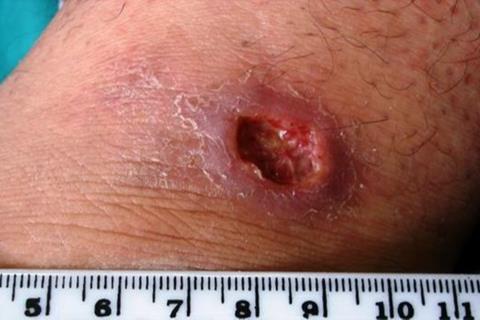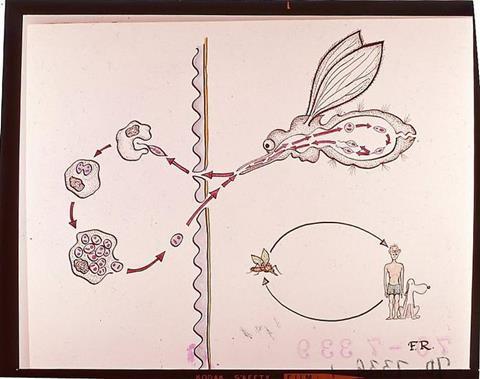Scientists have new evidence that a tropical disease once seen almost exclusively in returning travelers is now being detected in the United States in people with no international travel history — and caused by a Leishmania parasite strain that’s distinctly different from imported’ cases.

The analysis was revealed by researchers at the U.S. Centers for Disease Control and Prevention (CDC) presented at the Annual Meeting of the American Society of Tropical Medicine and Hygiene (ASTMH).
The study, led by CDC scientist Marcos de Almeida, emerged from a curious rise in domestic infections over the last 10 years, involving a potentially disfiguring skin disease called cutaneous leishmaniasis, which is caused by a parasite spread by bites from a sand fly.
American genotype
While most of the U.S. cases were in patients who had traveled to countries where leishmaniasis is common, there were 86 patients with no travel history. CDC scientists used genetic sequencing tools to analyze tissue samples from all of the patients.
They discovered that a strain of Leishmania mexicana infecting non-travelers had a slightly different genetic fingerprint, suggesting that their infections were caused by a uniquely American “genotype” of the disease that was spread by local sandfly populations.
“There have been previous indications of local transmission based on a small number of case reports, but now, for the first time, we have a distinct genetic fingerprint from a relatively large cluster, providing further evidence that leishmaniasis may be well-established in some parts of the United States,” said Mary Kamb, M.D., MPH, with the Division of Parasitic Diseases and Malaria at CDC’s National Center for Emerging and Zoonotic Infections.
“While most of these infections were in people living in Texas, sand flies that can transmit leishmaniasis are found in many parts of the country and especially in the southern United States.”
Skin ulcers
Cutaneous leishmaniasis infections typically produce skin ulcers that may take weeks or months to emerge post-exposure. There are medications to treat infections, but if allowed to progress, the disease can cause disfiguring scars.

In low-income countries, facial scars caused by cutaneous leishmaniasis have been linked to severe social stigma that is especially harmful for women. According to the World Health Organization, cutaneous leishmaniasis infects up to one million people annually, mainly in the Middle East, central Asia, northern Africa, and especially Latin America.
Kamb said that in Texas there is growing awareness of leishmaniasis as a potential diagnosis for skin lesions — in part due to a history of cases in people returning from Mexico, but also due to increasing recognition of the possibility of locally acquired cases.
In fact, in Texas, cutaneous leishmaniasis is a reportable condition. The enhanced recognition of the disease there might be a reason that many of the cases in non-travelers that had tissue specimens sent to CDC for testing were from Texas.
Lack of awareness
But she noted that a lack of awareness about leishmaniasis in other states makes it difficult to assess whether local transmission may be happening elsewhere.
For example, there have been isolated reports of local transmission in other states, but without the level of evidence — notably the distinct genetic fingerprint — revealed by this new study.
The CDC team hope that by linking domestic infections with a distinct strain, it will be easier to detect the emergence of locally acquired cases in new areas.
“A number of factors might be contributing to the increasing number of cutaneous leishmaniasis cases sent to CDC for testing. Among these is the speculation that that changes in climate conditions may lead to suitable environments for sand fly survival and reproduction, and that could enable the transmission of leishmaniasis to emerge in new areas,” said Vitaliano Cama, Ph.D., a senior advisor with CDC’s Division of Parasitic Diseases and Malaria who was closely involved with the leishmaniasis study. “There are still a lot of questions about where this disease is going and why.”
Life-threatening form
Meanwhile, growing evidence of cutaneious leishmaniasis circulating in U.S. sand fly populations is increasing concerns about risks that a life-threatening form of the disease, called visceral leishmaniasis, also could gain a foothold in domestic sand flies — chiefly by feeding on imported dogs that are carrying the disease.
Visceral leishmaniasis, which also is transmitted by sand fly bites, is caused by a different but related parasite called Leishmania infantum. It affects internal organs and kills between 20,000 and 30,000 people each year.
There are no drugs to prevent the disease, though there are vaccines commercially available in Europe and Brazil for dogs. There are medications for treating infections in people, though some have the potential to cause serious side effects and better drugs are under development.
At the ASTMH Annual Meeting, a special symposium on leishmaniasis risks in the United States featured a new study flagging the possibility that domestic sand fly populations could acquire visceral leishmaniasis parasites from the growing number of dogs coming into the country from regions where the disease is common. The study outlined a new risk assessment tool to promote better screening at the border.
Screening imported dogs
“Domestic dog imports from abroad, for breeding or via dog rescue organizations, have jumped sharply to the point that about a million dogs enter the U.S. every year — most without receiving proper screening for infectious diseases,” said Christine Petersen, DVM, Ph.D., FASTMH, who is director of the Center for Emerging Infectious Diseases at the University of Iowa. Petersen, who co-authored the study along with colleagues from the U.S. Army Veterinary Services, Johns Hopkins University and CDC, has worked globally to study human risks associated with visceral leishmaniasis infections in dogs.
“Dogs are the primary host for this disease, and there are dogs now regularly coming into the U.S. that have lived in areas where Leishmania parasites circulate in animals and people,” Petersen said. “That’s why we need a better system in the United States for guarding against the risk of introducing Leishmania infantum, one of the world’s deadliest tropical parasites, into U.S. sand fly populations.”
She said infected dogs can be treated with medications that reduce the number of parasites they carry, which lowers the risk they will transmit parasites when bitten by sand flies. But Petersen noted that most infected dogs will relapse, thus requiring regular screening and treatment as well as topical insecticide use on infected dogs to prevent spread to other dogs or people.
“Both forms of leishmaniasis cause tremendous suffering around the world and the fact that they now pose risks in the United States shows why we need to work together as a global community to fight infectious diseases wherever they exist,” said ASTMH President Daniel Bausch, M.D., MPH&TM, FASTMH. “A global approach is especially important as climate change allows insects that carry diseases like leishmaniasis, dengue and malaria to expand their range.”
Topics
- American Society of Tropical Medicine and Hygiene
- Christine Petersen
- cutaneous leishmaniasis
- Daniel Bausch
- Johns Hopkins University
- Leishmania infantum
- Leishmania mexicana
- Marcos de Almeida
- Mary Kamb
- Microbial Genetics
- One Health
- Parasites
- Research News
- U.S. Army Veterinary Services
- U.S. Centers for Disease Control and Prevention
- University of Iowa
- USA & Canada
- visceral leishmaniasis
- Vitaliano Cama







No comments yet